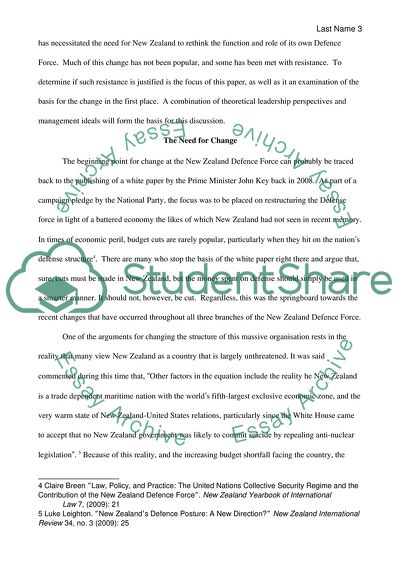Cite this document
(Change Throughout the New Zealand Defense Force Report Example | Topics and Well Written Essays - 2750 words, n.d.)
Change Throughout the New Zealand Defense Force Report Example | Topics and Well Written Essays - 2750 words. https://studentshare.org/politics/1830951-over-the-past-few-years-the-nzdf-has-undergone-significant-change-which-according-to-some-reports-has-had-a-negative-impact-on-the-members-of-the-organisation-as-well-as-the-organisation-as-a-whole-from-a-command-leadership-and-management-perspec
Change Throughout the New Zealand Defense Force Report Example | Topics and Well Written Essays - 2750 words. https://studentshare.org/politics/1830951-over-the-past-few-years-the-nzdf-has-undergone-significant-change-which-according-to-some-reports-has-had-a-negative-impact-on-the-members-of-the-organisation-as-well-as-the-organisation-as-a-whole-from-a-command-leadership-and-management-perspec
(Change Throughout the New Zealand Defense Force Report Example | Topics and Well Written Essays - 2750 Words)
Change Throughout the New Zealand Defense Force Report Example | Topics and Well Written Essays - 2750 Words. https://studentshare.org/politics/1830951-over-the-past-few-years-the-nzdf-has-undergone-significant-change-which-according-to-some-reports-has-had-a-negative-impact-on-the-members-of-the-organisation-as-well-as-the-organisation-as-a-whole-from-a-command-leadership-and-management-perspec.
Change Throughout the New Zealand Defense Force Report Example | Topics and Well Written Essays - 2750 Words. https://studentshare.org/politics/1830951-over-the-past-few-years-the-nzdf-has-undergone-significant-change-which-according-to-some-reports-has-had-a-negative-impact-on-the-members-of-the-organisation-as-well-as-the-organisation-as-a-whole-from-a-command-leadership-and-management-perspec.
“Change Throughout the New Zealand Defense Force Report Example | Topics and Well Written Essays - 2750 Words”. https://studentshare.org/politics/1830951-over-the-past-few-years-the-nzdf-has-undergone-significant-change-which-according-to-some-reports-has-had-a-negative-impact-on-the-members-of-the-organisation-as-well-as-the-organisation-as-a-whole-from-a-command-leadership-and-management-perspec.


